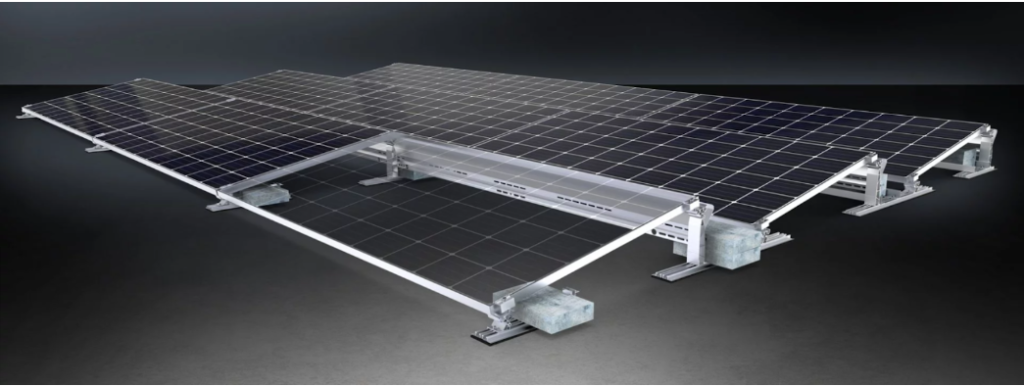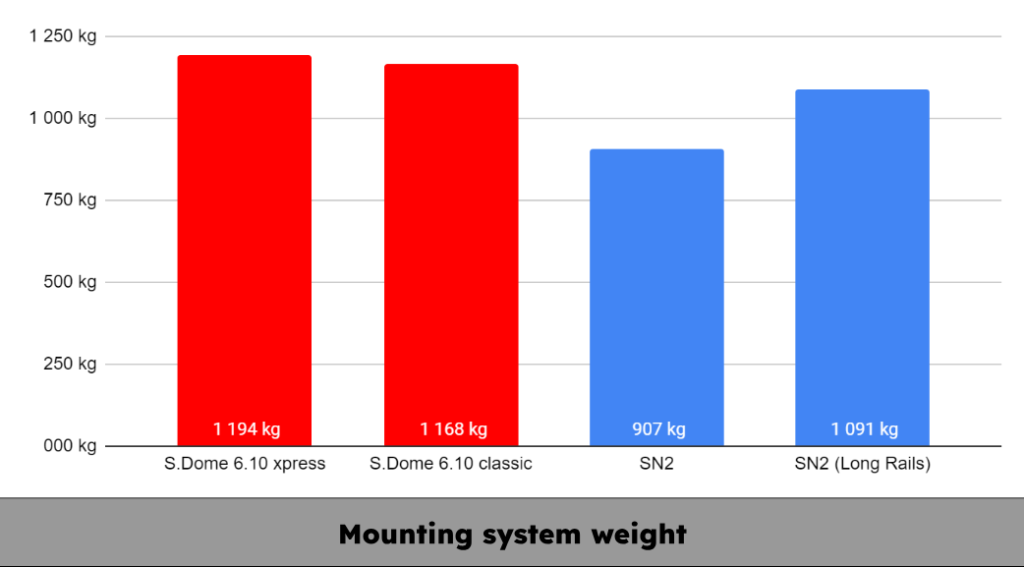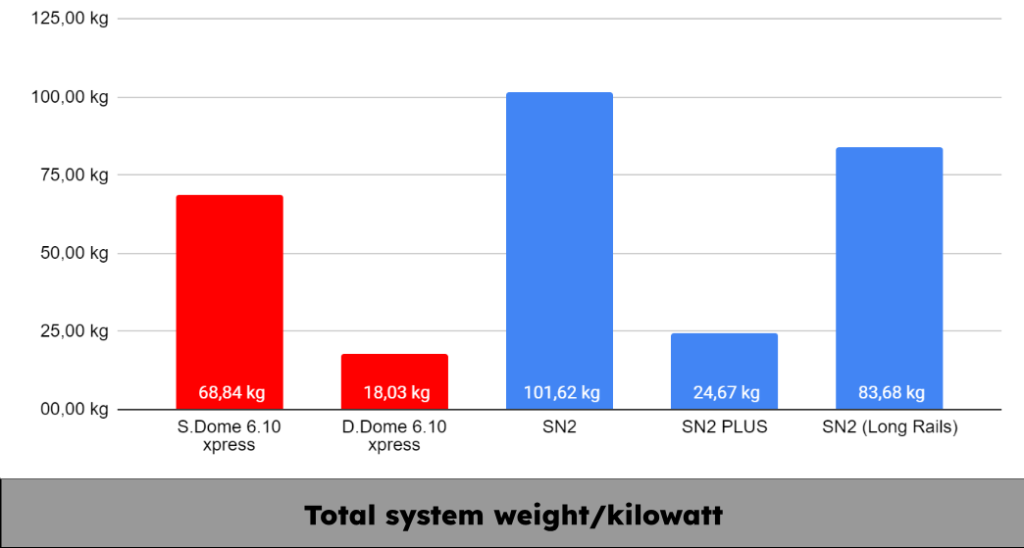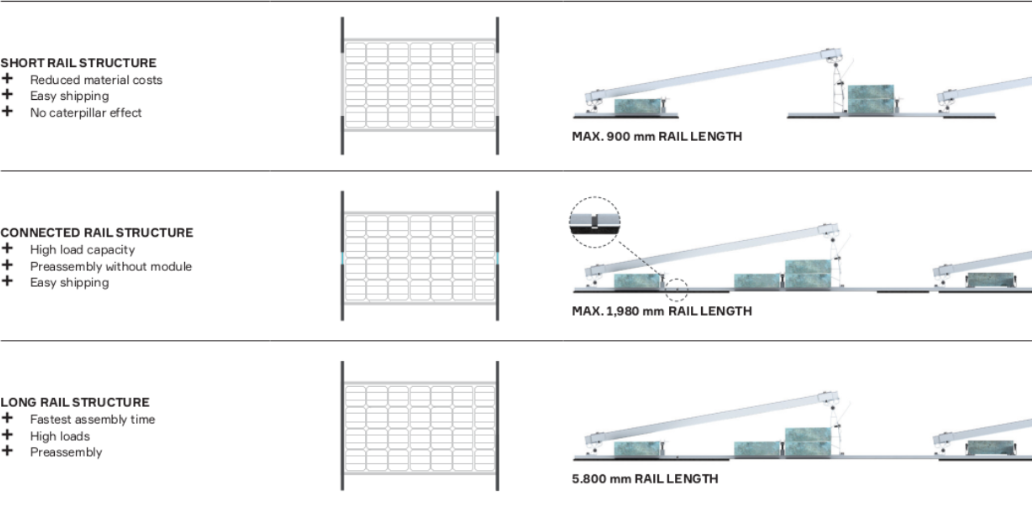K2 vs. Aerocompact flat roof solution comparison
Dome 6
K2 offers a wide range of products, and among them is the Dome 6, which is highly sought-after for its effectiveness in mounting solar panels on flat roofs facing south or east-west. The Dome 6 PV mounting system has a remarkable design which ensures exceptional stability, even in challenging weather conditions. Additionally, this system maximizes the utilization of space by allowing for the optimal placement of solar panels, thereby increasing their energy output. It is a highly adaptable solution, offering customers the choice between various inclinations, including 10° and 15°, in three different variations: basic, Xpress, and LS.
The basic version of the system requires on-site assembly, providing easier transportation but taking longer to install compared to its counterpart, the Xpress version. The Xpress version comes pre-assembled, eliminating the need for on-site assembly and significantly expediting the installation process.
With the help of the K2 Base, this solution is also easy to design in just a few simple steps. The design process includes all the necessary calculations for statics, bills of materials, and more. You can access the software online by visiting this website, where you can register for free and begin professionally designing your own projects.
SN2
Aerocompact offers a comparable solution for the same application as K2. They have recently introduced their latest flat roof mounting system called the SN2. It is available in both 5° and 10° inclinations, suitable for both south and east-west orientations. Aerocompact has also announced the availability of the 15° inclination version. However, it is important to note that this particular item is not currently available at the time of writing this article. Unlike K2, Aerocompact does not offer a pre-assembled version of its system. However, they provide different options for the rail:

Multi-component rail: This option utilizes pre-cut rails, each measuring a maximum of 90 cm in length, positioned just below the clamping points. Choosing this solution can result in cost and time savings in both materials and transportation. However, it is important to note that long-side clamping is not possible with this application, and it requires module assembly.
Connected rail: This option employs pre-cut rails, each measuring a maximum of 1980 mm in length. While the transport cost remains low due to the standard size below 2 m, it allows for long-side clamping. This solution provides a higher load capacity and facilitates easy shipping. However, it requires additional connector rails.
Long rail: With standard rails measuring 5800 mm in length, this option enables pre-assembly and offers the fastest installation time among the three choices. It boasts the highest load capacity of all the options available.
In order to accurately compare and compensate for two different brands’ solutions, we must create identical designs. Let’s establish the following guidelines: We will focus on a flat roof solution, specifically the south-oriented version, in the initial round. The flat roof will have a 3° inclination, be covered with foil, and stand at a height of 10 meters in the same coordinates. Additionally, we require the same type and quantity of PV modules. I have performed calculations based on 450 W modules, resulting in a total of 224 modules for a capacity of up to 100 kW.
Now, our task is to design both systems and compare their values. One crucial factor to consider for a flat roof mounting system is the ballast and weight. Let’s begin by examining the own weight of the mounting system for the south-oriented setup without incorporating any ballast:





When it comes to installing large commercial-sized modules, we encounter the need to clamp them on the long side. In such instances, the conventional mounting system structure is not suitable. However, both K2 and Aerocompact offer their own solutions to address this requirement. In this particular scenario, K2 once again exhibits a lighter weight, although the difference is noticeably smaller.
Considering all factors, we can conclude that the SN2 is slightly lighter than the Long Rails variant. However, it necessitates more ballast, resulting in heavier overall system weight. On the other hand, the SN2 system requires less material, making it easier to transport and quicker to install on the roof. When comparing the D-Dome and SN2 PLUS to their south-oriented variants, their total weight is significantly lower due to their minimal ballast requirement. In general, we can observe that K2 systems are slightly lighter than Aerocompact across all categories.
In addition to the ballast, another crucial aspect to consider is the price. Therefore, let’s compare the prices of these solutions. It is essential to factor in the cost of the ballast as it contributes to the overall installation expenses. As an average, I have calculated the value to be 0.12 € per kilogram. In this regard, K2 has an initial advantage due to the lower amount of ballast required. We will utilize the €/kW format for our price comparison.


In the case of the east-west oriented D-Dome and SN2 Plus systems, the situation has undergone a change. Surprisingly, K2 offers slightly lower prices, regardless of whether it’s short or long-side clamping. As expected, the classic version is slightly more affordable compared to the Xpress version. However, the long-side versions see a price increase of 30-50% due to the aforementioned reasons.
Considering all aspects, both brands are highly reputable and known for their excellent products. Each brand offers its own unique advantages, which may vary depending on the specific requirements of the project. In order to select the perfect mounting system for our project, it is important to take other factors into consideration as well. For instance, Aerocompact systems provide a generous 25-year product warranty, while K2 offers the convenience of a free online design tool called the Base. Aerocompact also has its own design software, available for all of our partners.
You can find all the mentioned products in this article on our webshop. If you have any inquiries, please don’t hesitate to reach out to our sales department at sales@solarity.eu. For technical assistance and design support, feel free to contact our local technical support colleague at pv-support@solarity.eu.
Author: Dániel Kovács, Technical Support

Subscribe to our newsletter
so that you don’t miss any news!











